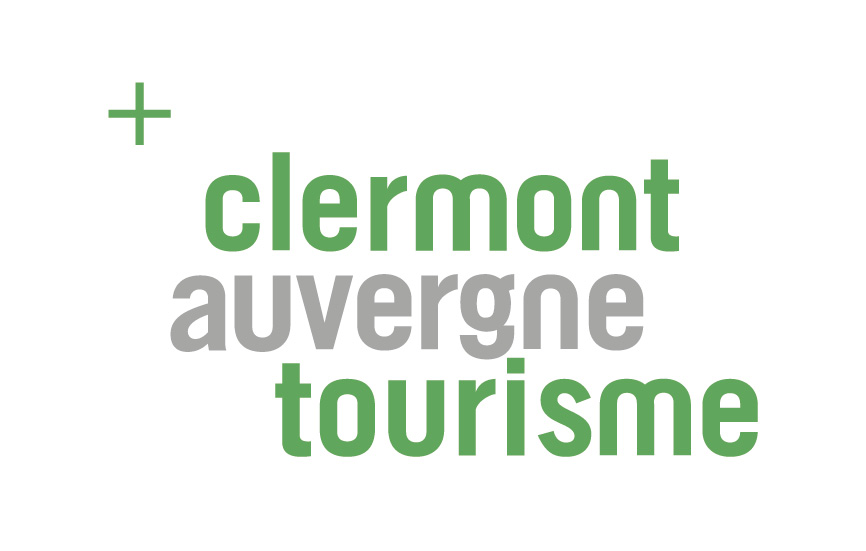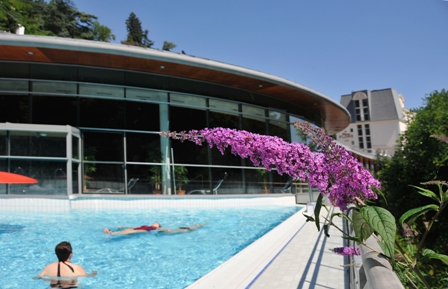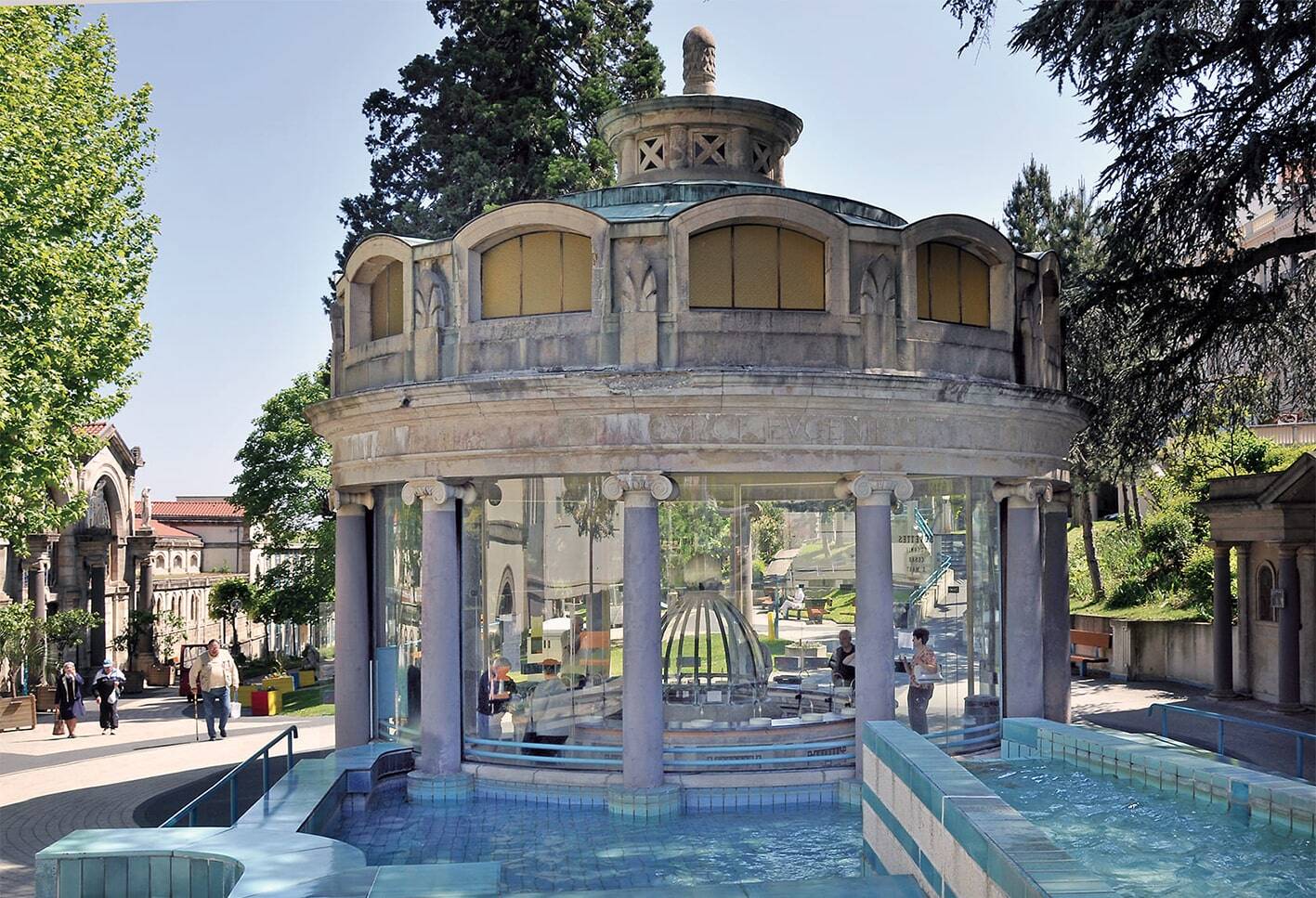The dramatic gorge of the River Tiretaine runs through Royat and Chamalières, not far from Clermond Ferrand and the Auvergne Volcanoes Regional Park. The spa town is reputed for being one of Europe’s most important centres for the treatment of cardiovascular diseases and rheumatology, always commited to innovation and medical research.
Although its origins can be traced back to the 7th century, the classic spa town did not properly developed until 1850’s, when the visits of Napoleon III and the arrival of the railway triggered its popularity. Today, a walk through its spa park will take you into a journey through Royat-Chamalières’ history, from the Gallo-Romans archaelogic ruins to the Belle Époque colourful mosaics of the Saint Mart Pavillion, just to finish your day with a refreshing thermal experience at the Royatonic, a modern termoludique spa centre.

Clermont Auvergne Tourisme - Royat Chamalières Office
Historical Background
Royat-Chamalières’s mineral springs were already known by the Gallo-Romans thousand year ago, as proved by the archeological works developed in the area. Excavations at the Source-des-Roches mineral spring revealed an ancient shrine filled with ex-votos, thousands of anthropomorphic figures showing limbs and internal organs that were offered to the water deities in search for health. Very close, ruins from extensive bath house, part of which can be seen in the spa park,were also discovered.
Nevertheless, the history of the town itself officially began in the 7th century, linked to the figure of Count Genesius and her wife Helidia. The couple, unable to have children,followed the advice of the bishop of Clermont, Saint Priest (Saint Praejectus) about dedicating part of their fortune to built a retreat for lone or “abandoned women” in order to gain divine favor. As a result, Genesius ordered the construction of three monasteries in Marsac, Royat and Chamalières between years 654-670. This was the basis for the development of the medieval villages connected by the TIretaine river, with plenty of water mills scattered along its banks.
By the mid-18th century the area started to became famous for its mineral spring, the first one - the Cesar spring - rediscovered in 1822. In the following years, and thanks to the interest of Antoine Védrine, priest in Royat, many other came into the light, including the one known as "Le Grand Source", which in 1844 began to be commercially exploited by a group of 18 investors lead by Antoine Zani. A first spa establishment was built between 1852-1856 and in 1862 it received the visit of Emperor Napoléon 3rd and Empress Eugénie. Since then, the baths would be known as "Source Eugénie".
The "Grand Hotel" was built by Léon Servant in 1865, and just 3 years after The Papon Concert hall opened its doors, followed by the Spa park (1874) and the Casino Chalet (1974). All these new constructions led to the development of a new urban planning for the budding spa town, where hotels and villas began to spread in order to acommodate the large numbers of visitors that arrived with the construction of the railway station in 1881 and the improvement of connections with Clermont-Ferrand. The long list of guests included the Prince of Wales, who visited the town in 1884, making Royat-Chamaliéres very popular among the English society.
Despite of this sucess, in 1911 the company responsible for the management of the springs - Compagnie générale des Eaux Minérales - went bankrupt. Soon new investors came to gave Royat- Chamalières a second flourishment and through the 1920's and 1930's a new Casino was built upon the ashes of the "Chalet", a well as the buvette of the Velleda spring and the iconic Saint-Mart Pavillion

The rapid growth of Royat-Chamalières starting in the 1850s followed the clasic model of the French spa town, with buvettes, thermes, casinos and hotels organised in a Quartier Thermale with its wide, green spa park. Volcanic mountains like the Puy de Dome provided the bucolic backdrop to the final picture
The Waters
Springs & Spa
Royat-Chamalières kept developing throughout the early 20th century, and despite the dark days of the second World War, the spa town reinvented itself with the establishment of the Institut de Recherches Cardio-Vasculaire (IRCV) in 1946, one of the first centres in Europe to cure cardiac problems and circulatory illnesses. The institute remains a leading research and treatment centre for cardiovascular diseases and rheumatology, renowned by its modern equipments, the professionalism of its medical team and, of course, the unique composition of its waters, 99.4 % pure carbonic.
The most used spring for local application is the Eugénie Buvette, with a constant abundant flow of 100.000 litres per hour. The warm mineral water, 32ºC temperature, is characterized by the extreme density of minerals and trace elements (5 grammes per litre).
Royat medical baths treat cardiovascular diseases and Raynaud phenomena, as well as rheumatolgical conditions (arthitis, fibromyalgia…) Thermal tecniques used include thermal mud wraps, sub-cutaneous thermal gas injections, water workout, immerged showers and steam showers.
Those seeking relaxation rather than the cure can enjoy the new Royatonic and its wide offer of wellness and beauty packages. This modern spa center displays a wide landscape of volcanic rocks, under an impressive dome, that includes caves, geysers and a big lagoon, plus the outdoors pool. Underwater currents swan necks, bubble beds, pressure jets, perfumed baths and jacuzzis are available to enjoy the pleasure of the hot thermal water, with temperatures between 32º and 24ºC.
A large hammam area and a Nordic area (saunas and cold water well) as well as booths for massages and esthetical cares are awaiting you for some royal relaxation moments.

Springs
Eugénie, César, Saint Mart, Saint Victor and Velleda (Royat) Auraline (Chamalières)
Earliest known use
1st century AD
Hottest Spring
37ºC
Chemical Elements
Arsenic

